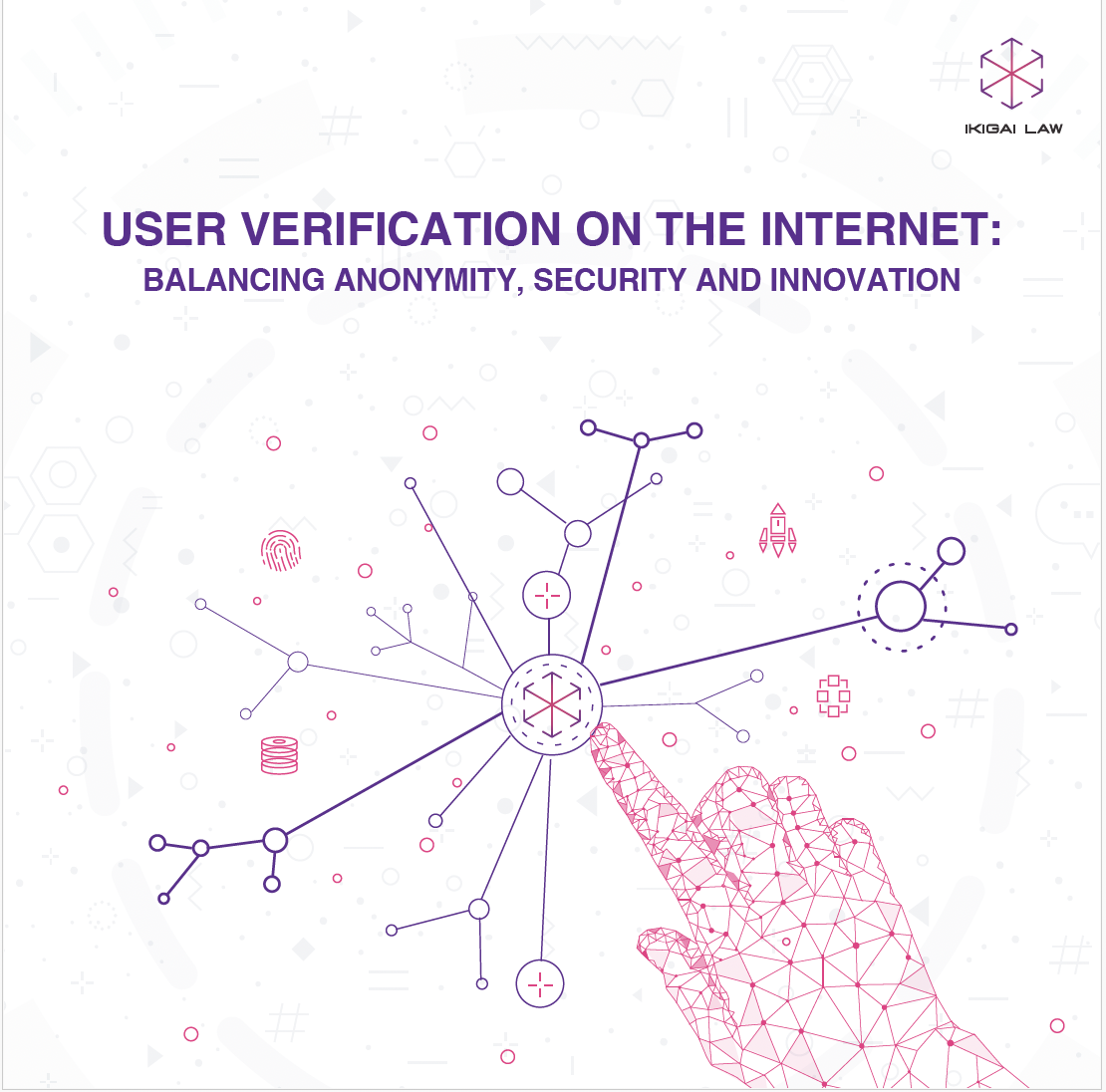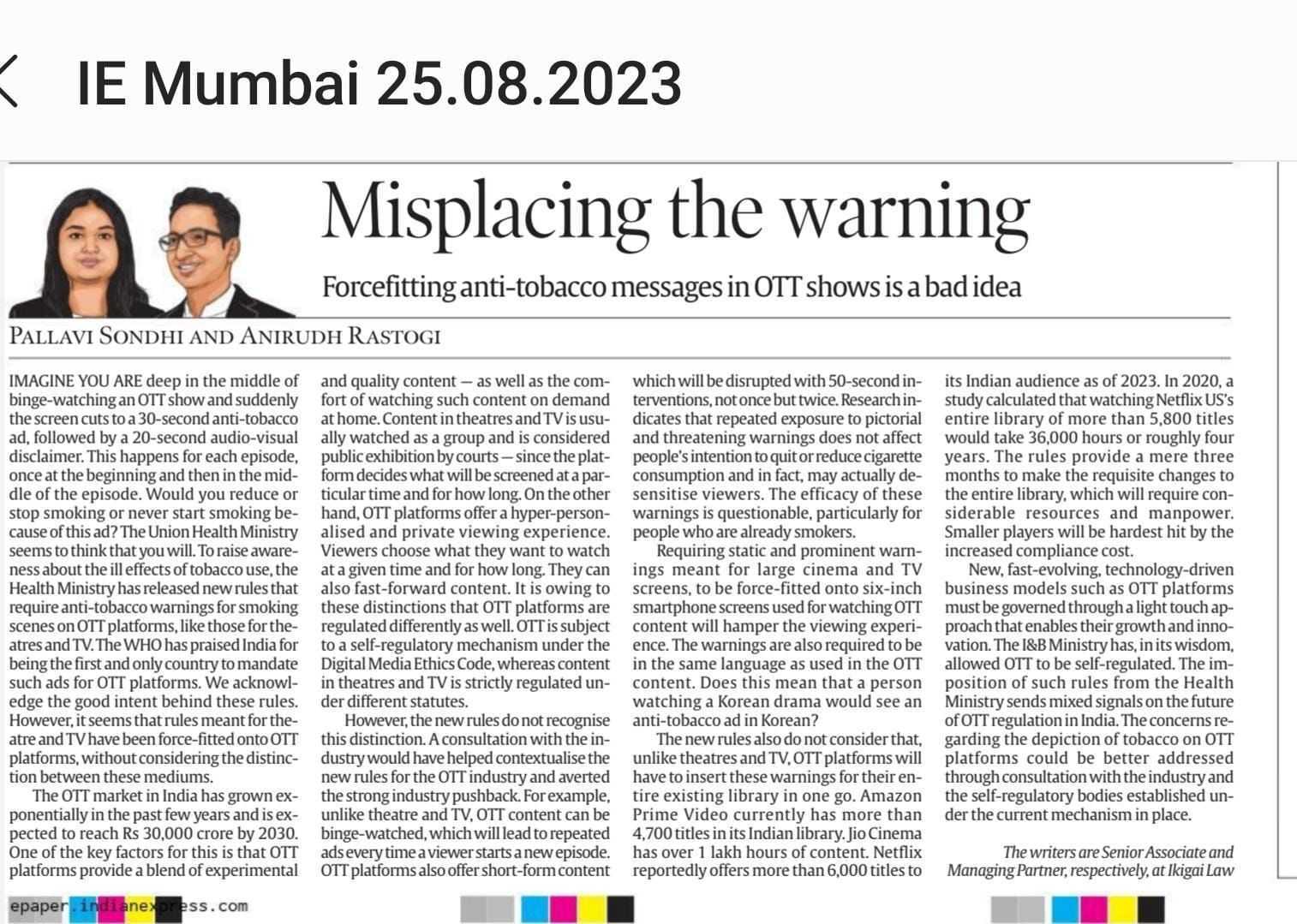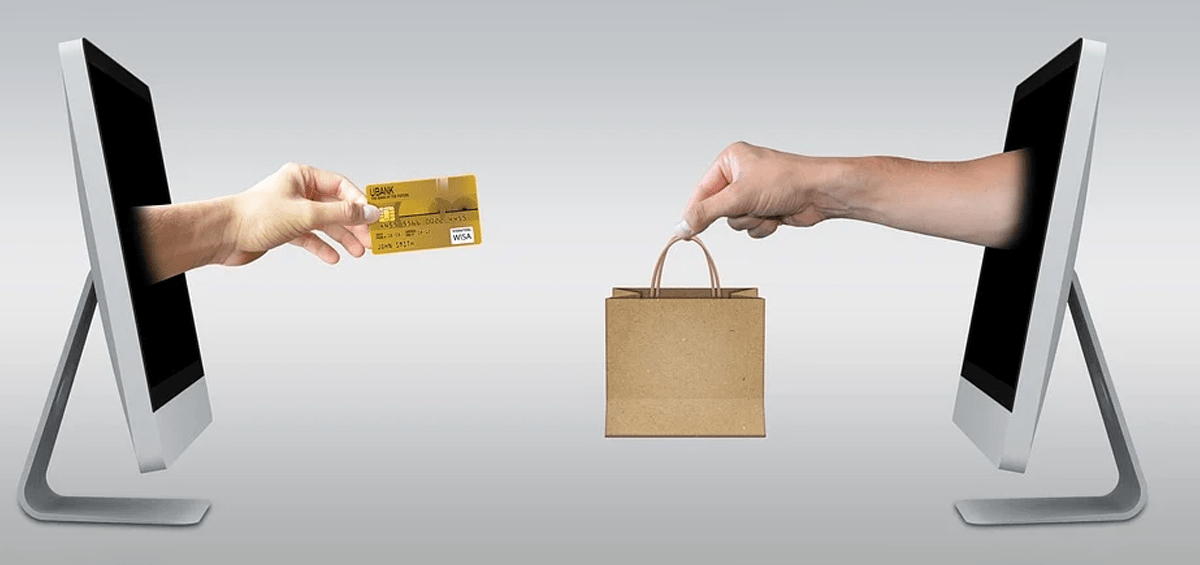The Abu Dhabi Global Market released the Electronic Transactions Regulations in September 2020, to recognize the use of electronic signatures, contracts and records. We, along with Arushi Goel (ex-Judge, India), a legal advisor based in the United Arab Emirates, submitted comments to the Abu Dhabi Global Market on the aforesaid regulations. We are pleased to note that many of our comments have been incorporated in the amended draft of the regulations.
1. PRELIMINARY
This submission presents comments to the Electronic Transactions Regulations (“Regulations”) proposed by the Abu Dhabi Global Market (“ADGM”). The submission highlights: (i) concerns with specific provisions of the Regulations with recommendations to address the same; and (ii) broad concerns with the Regulations.
2. SPECIFIC CONCERNS AND RECOMMENDATIONS
2.1. Determining “place of business” in electronic contracts
2.1.1. According to Regulation 11(3), an electronic communication is deemed to be dispatched at the place where the originator has its ‘place of business’ and is deemed to be received at the place where the addressee has its ‘place of business’, unless otherwise agreed between the parties. It is our concern that there isn’t enough clarity in the Regulations as to how to determine the ‘place of business’ of a party. It is possible that an entity may not have a single or a clear place of business. This is especially true in cases of virtual asset service providers, who operate digitally and may not have a physical place of business in any country or their place of business may not accurately depict the nexus with the underlying transaction. For instance, in Attorney General of the State of New York v. Bitfinex (“Bitfinex case”) the central question was whether the Attorney General had jurisdiction to conduct investigation against Bitfinex.[1] Bitfinex argued that it did not conduct business in New York, and therefore, the Attorney General did not have jurisdiction. Although it was held that the Attorney General had jurisdiction, the determination was finally based on Bitfinex opening bank accounts in New York and employing a New York based executive who conducted work from New York.[2] This case is an example of how uncertainty and unpredictability may arise in determining ‘place of business’ in cases involving virtual currency exchange.
2.1.2. To avoid similar challenges, the ADGM should consider providing some guidance to parties as to how to determine place of business in situations where in place of business may not be readily ascertainable. Taking guidance from the UNCITRAL Model Law on Electronic Commerce (“Model Law on E-Commerce”)[3] and the UNCITRAL Model Law on Electronic Transferable Records (“Model Law on E-Transferable Records”),[4] reference could be made to the place with the closest relation to the underlying transaction. Where the place of business is not applicable, reference could be made to the place of habitual residence.
2.2. ‘Reliability’ of electronic signatures
2.2.1. Under Regulation 13(1)(a), an electronic signature (“e-signature”) is deemed to identify the relevant person and the person’s intention to sign the electronic record if it is ‘reliable’ in light of all the circumstances. The Regulations do not define the term ‘reliable’ or provide conditions of reliability of an e-signature. This creates uncertainty and vagueness in understanding how the test of reliability can be met. Moreover, in cross-border transactions, the reliability test for e-signatures helps resolve legal incompatibilities between countries.[5]
2.2.2. This gap has been addressed by the UNCITRAL Model Law on Electronic Signatures (“Model Law on E-Signatures”), which under Article 6(3), sets out conditions under which an e-signature satisfies the test of reliability. These are: (a) the signature creation data are, within the context in which they are used, linked to the signatory and to no other person; (b) the signature creation data were, at the time of signing, under the control of the signatory and of no other person; (c) any alteration to the e-signature, made after the time of signing, is detectable; and (d) where a purpose of the legal requirement for a signature is to provide assurance as to the integrity of the information to which it relates, any alteration made to that information after the time of signing is detectable.[6] Similar conditions to determine reliability have also been adopted by other countries such as the People’s Republic of China.[7] While these conditions are not exhaustive, and relevant circumstances will be taken into consideration to determine reliability,[8] these conditions provide guidance to parties as to how the test of reliability can be met. This gives parties greater confidence in using e-signatures, especially in cross-border transactions.
2.2.3. Therefore, we recommend that the ADGM consider including conditions of reliability for e-signatures based on the Model Law on E-Signatures.
2.3. Exclusion of electronic negotiable instruments
2.3.1. Regulation 16(f) excludes negotiable instruments, bills of exchange and promissory notes from the ambit of the Regulations. However, this has implications going forward since digitization (including the use of distributed ledger technologies) is gaining traction for its ability to digitize negotiable instruments in a secure manner. Such exclusion may result in businesses, banks and financial institutions not being able to fully utilize the potential of distributed ledger technologies in digital financial transactions.
2.3.2. 80% of export trade finance is driven by open-account trading against buyers’ accepted bills of exchange or other negotiable instruments.[9] As soon as exporters receive bills of exchange or other negotiable instruments, they try to secure immediate funding against them from banks.[10] This, combined with paper-based receivables, has several challenges for banks including: (i) process inefficiencies like delays and errors with paper documentation and manual workflow results in process overheads and increased transaction costs;[11] (ii) fraud due to duplicate financing of receivables from multiple financers causes losses of billions of dollars. For instance, in 2014, a Chinese trading company financed the same collateral multiple times resulting in a loss of $3.2. billion to Chinese banks.[12] Other fraud practices include forging paper-based bills of exchange and invoices.[13] To overcome these challenges, blockchain technology can create fully digital bills of exchange, promissory notes and other negotiable instruments akin to financial contracts, to overcome fraudulent practices like duplicate financing and forging of bills of exchange, and reduce process inefficiencies.[14]
2.3.3. Currently, the most important challenge for digital negotiable instruments is the absence of a domestic legal framework recognizing them. However, there have been some developments on this front. Recently, the International Trade & Forfaiting Association revealed an initiative to digitize trade finance documents and urged the UK government to recognize digital negotiable instruments, bills of exchange and promissory notes.[15] In light of COVID-19, even the International Chamber of Commerce has called on governments to move to paperless trading.[16]
2.3.4. While blockchain based and other digital negotiable instruments are slowly gaining momentum, there are enough reasons to believe that electronic trade finance will hold significant importance in the future. Therefore, we recommend that ADGM, an international financial centre, should consider including negotiable instruments, bills of exchange and promissory notes within the ambit of the Regulations. It will be one of the first legal frameworks to fully recognize digital negotiable instruments and will immensely benefit ADGM registered banks and financial institutions who can slowly digitize negotiable instruments, and move towards secure and faster financing for trade.
2.4. Exclusion of documents used in commercial transactions and carriage of goods
2.4.1. Regulation 16(1)(f) excludes consignment notes, bills of lading, warehouse receipts or any transferable document or instrument that entitles the bearer or beneficiary to claim the delivery of goods or the payment of a sum of money. As described in 2.4.2 and 2.4.3 below, electronic commercial documents are recommended by international best practices and being adopted by countries. An exclusion of commercial and transport documents from the ambit of the Regulations creates a disadvantage to several businesses engaged in international trade, who cannot fully utilize the benefits of electronic commercial documents. Moreover, in accordance with international best practices, the Regulations should adopt progressive norms in light of changing technology.
2.4.2. The Model Law on E-Commerce recognizes the use and importance of electronic communication in cross-border commercial transactions including documents used in the context of carriage of goods by air, sea, rail or road.[17] Consequently, Article 16 gives recognition to a wide variety of electronic documents used in commercial transactions including transport documents, negotiable or non-negotiable bills of lading, documents for receipt of goods, charter-parties, among others.[18] The United Nations Convention on Contracts for the International Sale of Goods (“CISG”), adopted by 94 countries around the world, also recognizes the use of electronic documents for carriage of goods.[19] More recently, the 2017 Model Law on Electronic Transferable Records was enacted to govern the use of electronic transferable records such as bills of lading.[20] These international best practices offer a strong encouragement towards the use of electronic documents in commercial transactions.
2.4.3. Among domestic legislations, Australia’s Sea-Carriage Documents Act, 1996 recognises electronic and computerized sea-carriage documents.[21] Even in practice, the use of electronic bills of lading has become more common in Australia recently.[22] Other countries which support the use of electronic bills of lading include Brazil,[23] United States,[24] Germany.[25] Even Singapore is planning to adopt the use of electronic bills of lading.[26]
2.4.4. We recommend that, as a first step, ADGM could consider recognizing electronic bills of lading, considering the increase in their use and the emergence of several secure technologies for electronic bills of lading. An explicit recognition of electronic bills of landing will be a progressive step for ADGM at a time when several businesses are looking to digitize documentation, reduce time delays in international trade and make commercial transactions more efficient.
2.5. Exclusion of notarization of documents
2.5.1. Regulation 16(1)(e) excludes any document to be notarized before a notary public from the ambit of the Regulations. To reduce time delays and increase efficiency, electronic notarization is gaining popularity. Moreover, since the onset of Coivd-19, electronic notarization has become critical for business continuity.[27] Hence, there is a need to progressively move towards electronic notarization.
2.5.2. Countries such as the United States and European Union recognize electronic notarization under their e-commerce regulations.[28] In United States, 28 states have allowed remote online notarization (“RON”). In light of COVID-19, many other states issued emergency measures allowing RON.[29] RON laws allow documents to be notarized electronically on a platform using audio-visual technology.[30] The signer gains access to the RON platform where the notary verifies the signer’s identity, and witnesses the electronic signing of the document.[31] The notary then electronically notarizes the documents and returns the executed copies to the parties.[32] These sessions are recorded by the notary and saved in their records. While there are risks associated with electronic notarization such as fraudulent signer, documentation fraud and privacy concerns, a secure RON technology and thorough verification of the signer could alleviate these concerns.
2.5.3. We, therefore, recommend that the ADGM’s digital Notary Public consider adopting technology similar to RON, to allow electronic notarizing of documents for ADGM registered entities. This will improve the efficiency of businesses and allow them to offer a digitally transformative user experience. ADGM could consider excluding certain documents from electronic notarization such as documents related to adoption, divorce and other family law matters, wills and powers of attorney in sensitive matters such as healthcare, personal property and financial affairs.
2.6. Exclusion of power of attorney
2.6.1. Regulation 16(1)(a) excludes the creation, performance or enforcement of a power of attorney (“PoA”) from the ambit of the Regulations, thereby holding digital PoA invalid. While it may be necessary to exclude PoAs granted for sensitive matters such as healthcare and personal finance, a blanket exclusion excludes general PoAs pertinent for day to day functioning of businesses, banking transactions, litigation and real estate matters. Allowing digital PoAs for such matters helps businesses increase efficiency and reduce time delays. Countries such as the United States, Canada, United Kingdom, and countries in European Union allow digital creation of powers of attorney, with exceptions.[33] For instance, for matters of personal welfare and property, UK only allows the form to be filled online, but requires a wet ink signature.[34] Canada specifically excludes “powers of attorney, to the extent that they are in respect of an individual’s financial affairs or personal care.”[35] In Canada, according to a recent April, 2020, order audio-visual technology similar to RON is used for electronically signing PoAs.[36] Witnesses are also connected during such signing. A similar model is adopted even in Belgium.[37]
2.6.2. We recommend that ADGM consider a similar approach of allowing digital creation of PoAs for general matters and excluding them for sensitive matters like individual healthcare, welfare, finance and property. The PoAs can be signed and notarized digitally using a technology similar to RON as recommended at 2.5.2 above.
2.7. Exclusion of trust documents
2.7.1 Regulation 16(1)(b) excludes the creation, performance or enforcement of a declaration of a trust and includes provisions in the Trust (Special Provisions) Regulations 2016 (“Trust Regulations”) or the Foundations Regulations 2017 (“Foundations Regulations”) requiring information to be written or in writing. ADGM in its Consultation Paper has specifically stated that the only requirement for trust-related records to be “in writing” pertain to notices and resolutions given in pursuance of the Trust Regulations and the Foundation Regulations. These “in writing” requirements can be fulfilled in electronic form and will complement the fully digital application process already in place in ADGM. We, therefore, recommend that ADGM removes trust documents from the excluded matters.
2.8. Exclusion of immovable property documents
2.8.1. Regulation 16(1)(d) excludes the transactions involving the sale, purchase, lease (for a term of more than 10 years) and other disposition of immovable property and the registration of other rights relating to immovable property. Several countries in Europe including France, Spain, Denmark recognize electronic signing of sale purchase agreements.[38] However, for countries in the European Union, the Regulation (EU No 910/2014 (“eIDAS”) recognizes three types of e-signatures, namely ‘standard electronic signature’ which is typed or scanned, ‘authentic electronic signature’ and ‘qualified electronic signature’ which have additional security requirements.[39] Scotland allows sale and purchase agreements to be in an electronic form provided the signature used is an ‘authentic electronic signature’.[40]
2.8.2. We recommend that ADGM consider including sale and purchase agreements within the ambit of the Regulations. We understand that ADGM intends to adopt a minimalist approach without prescribing the use of any specific technology. However, for real estate agreements, ADGM could consider making an exception by adopting a prescriptive approach and prescribing certain secure forms of e-signatures. This will increase the scope of the regulations, and benefit businesses and individuals in reducing time delays in executing sale and purchase agreements.
3. GUIDANCE NOTE AND RECOMMENDATIONS
3.1. Cross-border recognition of e-signatures
3.1.1. In cross-border e-commerce transactions, two risks arise: (i) e-signatures are not legally valid in all jurisdictions. This may pose difficulties in electronically executing agreements with parties whose domestic laws don’t recognize e-signatures; and (ii) Several countries have technology-specific legislations, specifying the types of e-signatures that are recognized in their jurisdictions. Parties from technology-neutral countries may face technical incompatibilities in such countries.[41] In addition, several countries have adopted the Model Law on E-Signatures without any mention of Article 12 which recognizes the cross-border validity of all forms of e-signatures,[42] thereby reducing the chances of any common ground for regulating e-signatures. Considering ADGM intends to be a technology-neutral regime, it may want to address challenges that ADGM entitles may face in jurisdictions following a prescriptive or two-tiered approach.
3.1.2. In doing so, the ADGM could consider adopting the following measures: (i) ADGM could consider entering into mutual agreements with countries, especially those that strictly prescribe the use of certain technologies, agreeing to allow parties to mutually determine e-signatures for their electronic transactions. A similar approach has been adopted under the Australia-Japan Economic Partnership Agreement.[43] In addition, it provides that when a country’s laws require a high degree of reliability and security for certain transactions, the e-signatures will be adopted in accordance with that country’s laws.[44] Such an approach will ensure that ADGM entities will not face uncertainty in their electronic transactions in other jurisdictions; and (ii) ADGM could also consider entering into a regional cooperation agreement to ensure that e-signatures are valid in cross-border transactions between the Western Asian countries and allow parties the freedom to adopt their own e-signatures in electronic transactions.
[1] Attorney General of the State of New York v. Ifinex Inc., N.Y.S.C., 450545/2019, available at, https://www.blockchainlegalresource.com/wp-content/uploads/sites/31/2019/08/BlockchainBlog_in_the_matter_of_the_i_v_in_the_matter_of_the_i_decision___order_on_115-1-003.pdf.
[2] Blockchain Legal Resource, New York Attorney General Prevails in Investigative Dispute with Crypto Exchange, August 22, 2019, available at, https://www.blockchainlegalresource.com/2019/08/new-york-attorney-general-prevails-in-investigative-dispute-with-crypto-exchange/.
[3] UNCITRAL Model Law on Electronic Commerce, 1996, Article 15(4), available at, https://www.uncitral.org/pdf/english/texts/electcom/05-89450_Ebook.pdf (hereafter, Model Law on E-Commerce); See also UNCITRAL, Guide to Enactment of the UNCITRAL Model Law on Electronic Commerce at 58 (1996) (hereafter, .
[4] UNCITRAL Model Law on Electronic Transferable Records, Article 14 available at, https://uncitral.un.org/sites/uncitral.un.org/files/media-documents/uncitral/en/mletr_ebook_e.pdf.
[5] UNCITRAL, Promoting confidence in electronic commerce: legal issues on international use of electronic authentication and signature methods, at 67, available at, https://www.uncitral.org/pdf/english/texts/electcom/08-55698_Ebook.pdf.
[6] UNCITRAL Model Law on Electronic Signatures, 2001, available at, https://uncitral.un.org/sites/uncitral.un.org/files/media-documents/uncitral/en/ml-elecsig-e.pdf (hereafter, Model Law on Electronic Signatures).
[7] See Electronic Signature Law of the People’s Republic of China, Article 13, available at, https://www.wipo.int/edocs/lexdocs/laws/en/cn/cn105en.pdf.
[8] Model Law on Electronic Signatures, supra note 6, at Article 6(4)(a).
[9] Trade Finance Global, Negotiable Instruments are going through a makeover – the who, what, where, why, June 2, 2020, available at, https://www.tradefinanceglobal.com/posts/negotiable-instruments-are-going-through-a-makeover/.
[10] Id.
[11] Cognizant, Blockchain for Trade Finance Payment Instrument Tokenization (Part 4), May, 2018, at 4, available at, https://www.cognizant.com/whitepapers/blockchain-for-trade-finance-payment-instrument-tokenization-part-4-codex3517.pdf.
[12] Id.
[13] Id.
[14] Id.; See also Trade Finance Global, Negotiable Instruments are going through a makeover – the who, what, where, why, supra note 9.
[15] Global Trade Review, ITFA launches digital negotiable instruments initiative, presses UK government to update trade law, April 29, 2020, available at, https://www.gtreview.com/news/europe/itfa-launches-digital-negotiable-instruments-initiative-presses-uk-government-to-update-trade-law/.
[16] Global Trade Review, Governments urged to lift legal barriers to digital trade to mitigate Covid-19 impact, April 22, 2020, available at, https://www.gtreview.com/news/global/governments-urged-to-lift-legal-barriers-to-digital-trade-to-mitigate-covid-19-impact/.
[17] Model Law on E-Commerce, supra note 3, at Article 16; See also UNCITRAL, Guide to Enactment of the UNCITRAL Model Law on Electronic Commerce, supra note 3, at 58.
[18] Model Law on E-Commerce, supra note 3, at Article 16 and 17(1); See UNCITRAL, Guide to Enactment of the UNCITRAL Model Law on Electronic Commerce, supra note 3, at 58.
[19] CISG Advisory Council No. 11, Issues raised by documents under CISG focussing on the buyer’s payment duty, Adopted by the CISG-AC following its 16th meeting, (2012), available at, https://www.cisg.law.pace.edu/cisg/CISG-AC-op11.html.
[20] UNCITRAL Model Law on Electronic Transferable Records, available at, https://uncitral.un.org/sites/uncitral.un.org/files/media-documents/uncitral/en/mletr_ebook_e.pdf.
[21] Sea-Carriage Documents Act, 1996, Section 4, available at, https://www.legislation.qld.gov.au/view/pdf/inforce/current/act-1996-073.
[22] Global Trade Review, First electronic bill of lading used on Australia to New Zealand Trade route, available at, https://www.gtreview.com/news/asia/first-electronic-bill-of-lading-used-on-australia-to-new-zealand-trade-route/#:~:text=Swire%20Shipping%20has%20become%20the,a%20trade%20of%20containerised%20grain.
[23] Clyde & Co and International Chamber of Commerce, The Legal Status of Electronic Bills of Lading, (2018), available, https://iccwbo.org/content/uploads/sites/3/2018/10/the-legal-status-of-e-bills-of-lading-oct2018.pdf.
[24] Uniform Electronic Transactions Act, Section 5(b).
[25] German Commercial Code, Chapter 5, Section 516 (2).
[26] Computing, Singapore plans to adopt e-bills of lading to cut global trade costs, March 5, 2019, available at, https://www.computing.co.uk/news/3072027/singapore-plan-to-adopt-e-bills-of-lading-to-cut-global-trade-costs#:~:text=Singapore%20is%20planning%20to%20shift,for%20Communications%20and%20Information%20S.
[27] Holland & Knight, Remote online notarization: critical tool to ensure business continuity during Covid-19, March 17, 2020, available at, https://www.hklaw.com/en/insights/publications/2020/03/remote-online-notarization-a-critical-tool-during-covid19.
[28] For Europe, see Connective, New Belgian legislation enables notaries to work on remote by using qualified electronic signatures, April 23, 2020, available at, https://connective.eu/qualified-electronic-signatures-for-notary/; For United States, see DLA Piper, Coronavirus: Federal and state governments work quickly to enable remote online notarization to meet global crisis, September 23, 2020, available at, https://www.dlapiper.com/en/us/insights/publications/2020/03/coronavirus-federal-and-state-governments-work-quickly-to-enable-remote-online-notarization/#:~:text=If%20the%20SECURE%20Act%20becomes,in%20connection%20with%20interstate%20transactions.&text=The%20law%20becomes%20effective%20on%20January%201%2C%202021.
[29] DLA Piper, Coronavirus: Federal and state governments work quickly to enable remote online notarization to meet global crisis, supra note 28.
[30] American Bar Association Resources, Remote Online Notarization is Here to Stay, July 1 , 2019, available at, https://www.americanbar.org/groups/business_law/publications/committee_newsletters/banking/2019/201907/fa_2/.
[31] Id.
[32] Id.
[33] See Connective, New Belgian legislation enables notaries to work on remote by using qualified electronic signatures, supra note 28.
[34] For UK, see Law Commission, Electronic execution of documents, No. 386 (2019), available at, https://s3-eu-west-2.amazonaws.com/lawcom-prod-storage-11jsxou24uy7q/uploads/2019/09/Electronic-Execution-Report.pdf; For France see Notaries de France, available at, https://www.notaires.fr/en/couple-family/protecting-vulnerable-members-family/lasting-power-attorney.
[35] Section 31(3), Electronic Commerce Act, 2000, S.O. 2000, Ch. 17, available at, https://www.ontario.ca/laws/statute/00e17.
[36] Mondaq, Virtual Witnessing of Wills and Power of Attorneys, April 28, 2020, available at, https://www.mondaq.com/canada/wills-intestacy-estate-planning/923976/virtual-witnessing-of-wills-and-powers-of-attorney.
[37] Connective, New Belgian legislation enables notaries to work on remote by using qualified electronic signatures, supra note 28.
[38] CMS, Electronic Signatures in Real Estate Documents, https://www.cms-lawnow.com/ealerts/2020/04/electronic-signatures-in-real-estate-documents.
[39] RU Regulation EU No 910/2014, July 23, 2014, available at, https://eur-lex.europa.eu/legal-content/EN/TXT/?uri=uriserv:OJ.L_.2014.257.01.0073.01.ENG.
[40] Dentons, The current status of electronic signatures for real estate transactions in Scotland, England and Wales, July 1, 2019, available at, https://www.dentons.com/en/insights/alerts/2019/july/1/the-current-status-of-electronic-signatures-for-real-estate-transactions.
[41] UNCITRAL, Promoting confidence in electronic commerce: legal issues on international use of electronic authentication and signature methods, supra note 5, at 67.
[42] World Economic Forum, Making deals in Cyberspace: What’s the Problem?, White Paper (Oct., 2017), available at, http://www3.weforum.org/docs/WEF_White_Paper_Making_Deals_in_Cyberspace.pdf.
[43] Australia-Japan Economic Partnership Agreement, Article 13.6(1)(a), available at, https://www.dfat.gov.au/trade/agreements/in-force/jaepa/full-text/Pages/full-text-of-jaepa.
[44] Id. at Article 13.6(2).










